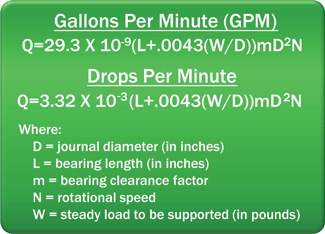Originally Posted By: TallPaul
A quote from the article,
Quote:
Fluid pressure is generated in the lubricant film, which is able to support load due to its viscosity. Lubricating oils have a significant pressure-viscosity coefficient. This means that the greater the pressure on the lubricant, the higher the viscosity at the pressure point. In the case of rolling-element bearings, this pressure is high enough to raise the lubricant’s viscosity to the point where it will deform the bearing’s rolling elements. This pressure-viscosity coefficient is what provides the load-carrying capacity of a journal bearing.
The writer is confusing a few issues....the article is really more about flow requirement, and less about the viscosity/pressure interaction. He mixes and matches roller bearings and plain bearings.
The formulae provided are an adaptation from steam train drip feeders and the like
Quote:
Fluid pressure is generated in the lubricant film, which is able to support load due to its viscosity.
The pressure is generated by the oil remaining stationary relative to the surfaces that it's attached to. The oil adjacent to the shaft is moving at shaft speed, and that at a bearing is stationary relative to the bearing...there's a gradient of velocities between them.
The turning shaft drags the oil with it in the direction of rotation, and this oil is forced into a narrowing clearance on the loaded side of the bearing, this creates the pressure within the bearing, and keeps the parts separate...this is hydrodynamic lubrication.
The oil obviously wants to squeeze out the ends of the bearing, and does. Viscosity slows the rate of side leakage, provides greater MOFT, and reduces the make-up requirement.
The statement
Quote:
This pressure-viscosity coefficient is what provides the load-carrying capacity of a journal bearing.
Is incorrect in a journal bearing...it's THERE, but hydrodynamics provides the load carrying capacity, and viscosity is a big part...the viscosity pressure in a journal bearing only modifies the viscosity, and not a lot.
Quote:
Lubricating oils have a significant pressure-viscosity coefficient. This means that the greater the pressure on the lubricant, the higher the viscosity at the pressure point. In the case of rolling-element bearings, this pressure is high enough to raise the lubricant’s viscosity to the point where it will deform the bearing’s rolling elements.
That's where he mixes his cases, and gets the casual observer confused.
If you look at a ball bearing, and consider them to be rigid as a first approximation, the roller contacts the race at a point...there is infinite pressure at that point, and no material can handle that.
If you consider the bearing materials now to be real, the ball flattens ever so slightly, and the race gives a little and forms a "cup" around it...this deformation will take place until the average contact pressure times the new found surface area is enough to hold the load...those pressures are nothing like the infinite one in the rigid assumption, but are massively high. These are called "Hertzian" stresses.
(Consider that this deformation takes place on the ball and race every time the roll into the direction of load...that's why roller bearings always eventually fail, and have to be maintained...also same thing happens to train tracks).
Under these pressures is a regime called Elastohydrodynamics (EHD), elastic behaviour of the metal, and incorporating hydrodynamics...the pressures are extreme, and the viscosity in that regime has been measured to be that close to soft metals...that property helps them stay in the contact zone and not get squeezed out for the fraction of time that they are under load.
Consider now back to the journal bearing, the surface is soft (used to be lead/tin, but are now going to aluminium etc. They can't handle those sorts of pressures without deforming plastically (permanent shape change), so the operating pressures are limited to a tiny fraction of that which the roller bearings operate at.
There will be pressure/viscosity changes in the lubricating system.
the equation for pressure/viscosity changes is (np is viscosity at pressure, na is viscosity at atmospheric)
np = na x e^(alpha x pressure), alpha is pressure viscosity co-efficient, and for mineral oils it's around 15x10^-9 (0.000000015).
So at an 80 psi 550,000 pascals oil supply pressure, the viscosity is modified by 1.008, 8 tenths of a percent.
In a journal bearing at 40MPa pressure 5,800 psi, the effect is there, but around 70%, and ONLY at the point of maximum pressure. Take a 20W20 and the viscosity... at the point of maximum pressure...will go from 9 to 15. Put an SAE 40 in it, and 14cst becomes 24cst.
In a roller bearing, due to the behaviour described above, the contact pressures can be 1GPa 145,000psi...putting it into that equation suggests that the localised viscosity change is around 3 million...the formula doesn't work at those sorts of pressures, but it's a massive increase, as I said, to near the point of soft metals, and is really the only reason that roller bearings survive at all.
(*)...the bearing materials are becoming harder, as they are dropping viscosity, pushing more into the EHD realms, and need a harder material to handle the pressures.


